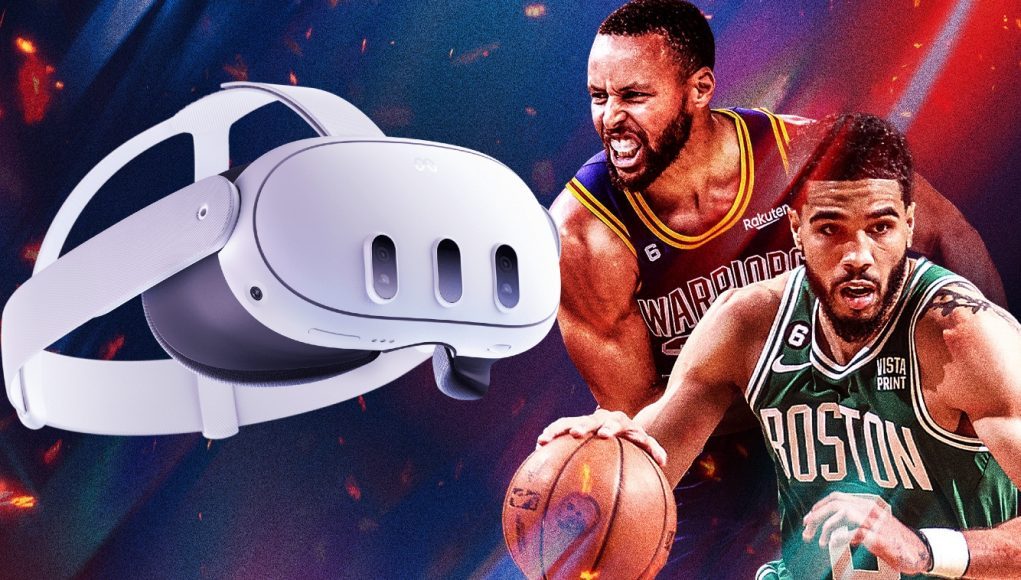The NBA announced it’s expanding the number of games it’s recording for Quest headsets by a wide margin, bringing a ton of 180-degree immersive games to NBA League Pass holders.
Games will be available in both through the Xtadium app on Quest and Meta Horizon Worlds—both of which require the NBA League Pass subscription viewing service to access. Games on Xtadium have already begun, while games on Horizon Worlds kick off November 17th.
Note: Xtadium and NBA League Pass VR games are only available in the US.
Each app has it own perks. Xtadium lets you do a ‘Watch Party’, where you can invite friends to join you in your own private party room and catch the game together in VR as avatars. It also lets you watch games on-demand, watch up to eight games in 2D simultaneously, and watch games in mixed reality mode.
The NBA Arena in Horizon Worlds is set to include interactive games like the Slam Dunk Jam and Basket Blitz. There’s also set to be plenty of opportunities to mess around in a stadium environment, unlock stickers, emotes, exclusive avatar wearables, and access to the VIP Lounge by attending immersive games or playing mini-games in NBA Arena. You’ll even be able to buy your avatar NBA or WNBA team apparel, which you can wear in VR as well as on Facebook, Messenger, and Instagram.
As always, the standard set of NBA League Pass geo-restrictions apply, which means some games may not be available in all regions, and viewers located near the physical event may be unable to view it based on localized restrictions.
Here’s the full schedule:
- October 25 // Atlanta Hawks vs. Charlotte Hornets // 4:00 pm PT
- October 28 // Memphis Grizzlies vs. Washington Wizards // 4:00 pm PT
- October 30 // Miami Heat vs. Milwaukee Bucks // 5:00 pm PT
- November 3 // Golden State Warriors vs. Oklahoma City Thunder // 5:00 pm PT
- November 6 // San Antonio Spurs vs. Indiana Pacers // 4:00 pm PT
- November 10 // Minnesota Timberwolves vs. San Antonio Spurs // 5:00 pm PT
- November 14 // Dallas Mavericks vs. New Orleans Pelicans // 5:00 pm PT
- November 17 // Philadelphia 76ers vs. Atlanta Hawks // 4:30 pm PT
- November 18 // New York Knicks vs. Charlotte Hornets // 3:00 pm PT
- November 21 // Toronto Raptors vs. Orlando Magic // 4:00 pm PT
- November 24 // Detroit Pistons vs. Indiana Pacers // 5:00 pm PT
- November 25 // Los Angeles Lakers vs. Cleveland Cavaliers // 4:30 pm PT
- November 28 // Chicago Bulls vs. Boston Celtics // 4:30 pm PT
- December 2 // Indiana Pacers vs. Miami Heat // 5:00 pm PT
- December 11 // Denver Nuggets vs. Atlanta Hawks // 4:30 pm PT
- December 14 // Chicago Bulls vs. Miami Heat // 4:30 pm PT
- December 16 // Philadelphia 76ers vs. Charlotte Hornets // 4:00 pm PT
- December 18 // LA Clippers vs. Indiana Pacers // 4:00 pm PT
- December 20 // Los Angeles Lakers vs. Chicago Bulls // 5:00 pm PT
- December 21 // San Antonio Spurs vs. Chicago Bulls // 5:00 pm PT
- December 23 // San Antonio Spurs vs. Dallas Mavericks // 5:30 pm PT
- December 27 // New York Knicks vs. Oklahoma City Thunder // 5:00 pm PT
- December 30 // Los Angeles Lakers vs. Minnesota Timberwolves // 5:00 pm PT
- January 2 // Boston Celtics vs. Oklahoma City Thunder vs. 5:00 pm PT
- January 6 // Utah Jazz vs. Philadelphia 76ers // 4:30 pm PT
- January 8 // Boston Celtics vs. Indiana Pacers // 4:00 pm PT
- January 9 // Portland Trail Blazers vs. New York Knicks // 4:30 pm PT
- January 13 // New York Knicks vs. Memphis Grizzlies // 5:00 pm PT
- January 15 // Indiana Pacers vs. Utah Jazz // 6:00 pm PT
- January 20 // San Antonio Spurs vs. Washington Wizards // 4:00 pm PT
- January 21 // Denver Nuggets vs. Washington Wizards // 3:00 pm PT
- January 26 // Cleveland Cavaliers vs. Milwaukee Bucks // 5:00 pm PT
- January 28 // Oklahoma City Thunder vs. Detroit Pistons // 3:00 pm PT
- January 29 // New Orleans Pelicans vs. Boston Celtics // 4:30 pm PT
- February 2 // Miami Heat vs. Washington Wizards // 4:00 pm PT
- February 3 // Brooklyn Nets vs. Philadelphia 76ers // 3:00 pm PT
- February 5 // Dallas Mavericks vs. Philadelphia 76ers // 4:00 pm PT
- February 9 // Charlotte Hornets vs. Milwaukee Bucks // 5:00 pm PT
- February 12 // Denver Nuggets vs. Milwaukee Bucks // 5:00 pm PT
- February 26 // Brooklyn Nets vs. Memphis Grizzlies // 5:00 pm PT
- March 1 // Indiana Pacers vs. New Orleans Pelicans // 5:00 pm PT
- March 4 // Portland Trail Blazers vs. Minnesota Timberwolves // 5:00 pm PT
- March 11 // Phoenix Suns vs. Cleveland Cavaliers // 4:30 pm PT
- March 15 // Denver Nuggets vs. San Antonio Spurs // 5:30 pm PT
- March 16 // Cleveland Cavaliers vs. Houston Rockets // 2:00 pm PT
- March 21 // Utah Jazz vs. Dallas Mavericks // 5:30 pm PT
- March 24 // Golden State Warriors vs. Minnesota Timberwolves // 4:00 pm PT
- March 29 // Phoenix Suns vs. Oklahoma City Thunder // 5:00 pm PT
- March 31 // Los Angeles Lakers vs. Brooklyn Nets // 3:00 pm PT
- April 5 // New York Knicks vs. Chicago Bulls // 5:00 pm PT
- April 7 // Sacramento Kings vs. Brooklyn Nets // 4:30 pm PT
- April 12 // Orlando Magic vs. Philadelphia 76ers // 4:00 pm PT







